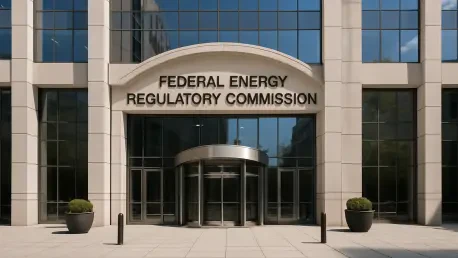In a development that has sent ripples through the energy sector, the Federal Energy Regulatory Commission (FERC) finds itself at a critical juncture as Mark Christie, its chairman, stepped down from his role on a recent Friday. This departure, after a four-year tenure under a nomination by former President Donald Trump, leaves the agency with just three sitting commissioners at a time when the stability of the U.S. energy grid faces mounting scrutiny. Christie’s exit, coupled with his prior warnings about potential grid reliability crises, underscores the urgency of addressing aging infrastructure and evolving energy demands. Having served nearly 17 years at the Virginia State Corporation Commission before joining FERC, Christie brought a wealth of experience to the role. Upon leaving, he shared an optimistic outlook on social media, hinting at future endeavors without plans for retirement. This transition raises questions about the agency’s direction and the broader implications for national energy policy.
Leadership Transition and Political Dynamics
The resignation of FERC’s chairman has paved the way for a notable shift in leadership, with the White House appointing Commissioner David Rosner, a Democrat, as interim chairman. This decision stands out as a rare instance of a Republican administration passing the reins to a member of the opposing party, reflecting a strategic choice amid complex political currents. Rosner, who earned significant bipartisan support during his Senate confirmation, will guide the agency alongside remaining commissioners Lindsay See, a Republican, and Judy Chang, a Democrat. Industry experts suggest this interim appointment signals confidence in Rosner’s ability to navigate pressing issues, though it also highlights the absence of a permanent chair. The selection may tie into broader policy goals, such as fostering data center co-location with power plants, a topic that has already sparked debate within FERC. As the agency operates with a minimal quorum, the balance of perspectives among the trio will be crucial in shaping immediate decisions.
Further complicating the leadership landscape are the pending nominations to fill FERC’s two vacant seats, which are essential for maintaining robust decision-making capacity. President Trump has put forward Laura Swett, an experienced energy attorney with prior FERC staff experience, and David LaCerte, a current official with the U.S. Office of Personnel Management, for these roles. Their confirmations, awaiting review by the Senate Energy and Natural Resources Committee and the full Senate, could extend over several months. Until these positions are filled, potential conflicts of interest from the current commissioners’ past affiliations might delay critical rulings. This transitional period underscores a delicate interplay of political dynamics at FERC, where bipartisan cooperation and strategic appointments will play a pivotal role. The outcome of these nominations will likely influence the agency’s approach to emerging challenges and long-standing grid reliability concerns.
Grid Reliability and Policy Challenges
During his tenure, the outgoing chairman consistently highlighted a looming crisis in grid reliability, driven largely by the retirement of aging power plants across the country. His vocal concerns pointed to the urgent need for modernizing infrastructure to keep pace with rising energy demands and the integration of renewable sources. Christie advocated for a cautious approach to financial incentives for transmission line development, arguing that unchecked expansion could burden consumers without guaranteeing stability. Additionally, he expressed skepticism toward capacity markets, questioning their effectiveness in ensuring a resilient energy supply. These positions stirred debate within the industry, as stakeholders grapple with balancing cost, innovation, and reliability. As FERC moves forward under interim leadership, these unresolved issues remain at the forefront, demanding thoughtful policy solutions to safeguard the nation’s energy future against potential disruptions.
Another pressing policy challenge centers on the integration of technology with energy infrastructure, particularly the co-location of data centers with power plants. A recent 2-1 vote in November revealed deep divisions within FERC, with Christie and See opposing an interconnection agreement for expanded power sales to a data center at the Susquehanna nuclear plant in Pennsylvania, while Rosner and Chang abstained. This issue, tied to broader discussions within the PJM Interconnection, signals a growing tension between traditional energy frameworks and modern technological needs. Under interim leadership, FERC is expected to explore innovative policy options to address co-location, a topic that could redefine how energy resources are allocated. The resolution of such debates will test the agency’s ability to adapt to evolving industry trends while maintaining a stable grid, especially as data-driven enterprises continue to expand their footprint across the energy landscape.
Shaping the Future of Energy Oversight
Reflecting on the recent shifts at FERC, the resignation of its chairman marked a turning point that prompted intense focus on the agency’s capacity to address systemic energy challenges. The interim appointment of David Rosner as chairman introduced a nuanced layer of bipartisan collaboration, while ongoing policy disputes over grid reliability and technological integration underscored the complexity of the agency’s mission. Looking ahead, the energy sector must prioritize actionable strategies to bolster infrastructure resilience, such as accelerating investments in grid modernization and refining regulatory frameworks for emerging technologies. Stakeholders should closely monitor the Senate’s progress on confirming new commissioners, as their input will be vital in steering FERC’s long-term priorities. Additionally, fostering dialogue between policymakers and industry leaders could pave the way for balanced solutions that address both reliability and innovation. As FERC navigates this critical juncture, its decisions promise to leave a lasting impact on the nation’s energy landscape.









